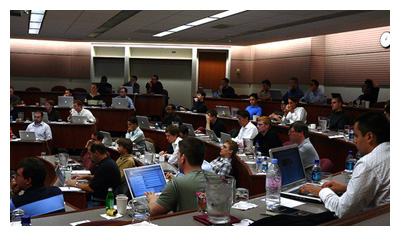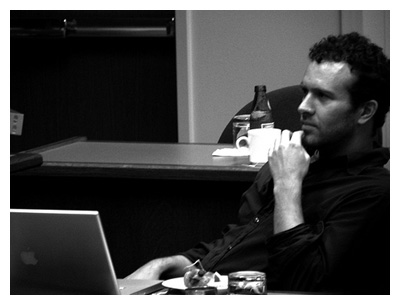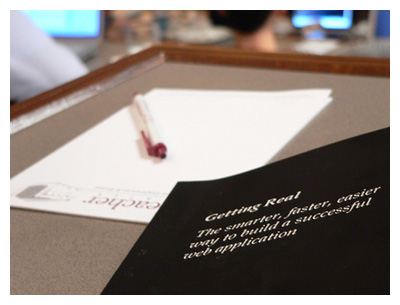As 37signals' "Getting Real" workshop begins, a few things are immediately apparent. First, this is a total stag party: in a room of around 60 men, there are two women. Second, Steve Jobs would be proud: almost everyone is hunched over a Mac- or PowerBook. Third, for Jason Fried and his partner David Heinemeier Hansson, this "Getting Real" stuff is more than just a guiding principle. It's virtually a religion. These are true believers, and their seminar proves an effective, if expensive (a day runs just under $900, and for many, there's also travel; someone's here from Australia), introduction to indoctrination.

As the primary presenters, Fried and Hansson make a charismatic duo, sometimes finishing, other times amplifying each other's thoughts on how their team has turned Fried's Chicago-based web design firm into one of the most talked about internet-based software shops in the business. Lately, there are a lot of people to be talking: the company's flagship product, Basecamp, has around a million users, and, on a given day, tens of thousands of readers tune into the company's blog, Signals vs. Noise. Ostensibly about "design and usability," it also comprises the majority of the firm's marketing. In posts that are frequently provocative, SvN engages the converts and riles up the doubters... there is, after all, no bad publicity.
Back to the live show: there's something ironic about the 37signals crew using a lecture hall at the University of Chicago's business school to present their iconoclastic ideas about how to "Get Real." Hard to know how many tenured faculty are instructing the Future Business Leaders of America to "emulate drug dealers," but those are Fried's words as he recommends offering free samples to get customers hooked. And, while many firms make overtures to empowering employees with decision-making autonomy, few use such emphatic terms as Hansson, who advocates for "happiness-driven programming." Forget your troubles, come on, get codin', right?
When it comes to web-based software, with its capacity for constant revision, the jump right in approach makes some sense (and, clearly, it's made these guys a lot of money -- Amazon's Jeff Bezos recently bought in as a minority partner; terms weren't disclosed). Hansson points out that while a developer knows nothing about how a project will work on day one, within two weeks, he or she knows "endlessly more." Anyway, Fried chimes in, "most things you worry about just don't matter that much." Better to make progress than to get hung up on abstractions that will sort themselves out once they become, well, real.

But there's one precept that'd definitely get some b-school folks riled up: "'good enough' is a driving force in everything we do," Hansson says. For decades, "quality" has been the watchword of industry, and these guys are espousing the "good enough" benchmark? Ryan Singer, the on-staff designer, takes pains to clarify that this tactic doesn't necessarily equate with a lack of attention to detail; instead, it's more about good old-fashioned compromise. Hansson describes a scenario of being given a spec and determining it would take 20 hours to execute it exactly. Or, in two hours, he could achieve the fundamentals of the desired result. Recognizing that sometimes the exact outcome is necessary regardless of expense or effort, Hansson says most 37signals decisions are driven by the opportunity costs associated with those 18 hours.
If this is Getting Real doctrine, it's no surprise that Fried professes a preference for economics, with its focus on the social, over finance, with its focus on the monetary. The 37signals philosophy emphasizes experience over all else, whether it be the happiness of the programmer or the usability of screen navigation ("Layout," Singer says with conviction, "is supposed to do something"). The qualitative nature of experience, Fried contends, allows it to be leveraged in ways the quantitative can't. He uses the example of celebrity chefs. By presenting their dishes in non-stop Food Network re-runs, Lagasse, Flay and Battali may be giving away their raw materials, but Fried argues the "recipes don't matter." Rather, it's the personalities doing this "sharing" that people flock to, whether for entertainment or education. Of course, nowhere is that phenomenon more evident than in this lecture hall -- and, with their telegenic looks and easy banter, it's not hard to picture Fried and Hansson behind a studio cooktop, Singer offering the occasional professorial interjection.

After all, the 37signals manifesto can be anyone's for less than 20 bucks. A PDF isn't quite the same as warm bodies and a Keynote presentation, sure, but what of those opportunity costs? Which here aren't just lost time, but cash money. Like eating at Emeril's, the workshop is pretty much an expense account-only proposition. If you're Facebook, and you're fending off corporate suitors daily, you can afford to send a few folks. But for the curious, Getting Real: The Book is the way to go -- think of it as buying the latest edition of Rachael Ray's 30 Minute Meals. Sure, you could copy everything down off the TV screen or collate the blog posts, but, again, think of the opportunity costs.
The book, while targeted to an audience of "entrepreneurs, designers, programmers, or marketers working on a big idea," invites readers to consider how Fried & co.'s no-nonsense ideas about business might play out in the realm beyond the Web. The introduction ends with the claim that, "Once you start Getting Real in one area of your life, you'll see how these concepts can apply to a wide range of activities." Overreaching, perhaps, but this is a creed. The voice is vibrant with opinion, and the glibness can sometimes grate, as can the use of "less" in place of "fewer," but the book's often engaging in ways management texts rarely are. Given a willingness to skim through the especially tech-y stuff, there's potential cross-over appeal. Plus, the on-page presentation is remarkably elegant. For instance, the layout (which, remember, has to "do something") sometimes transforms prose into free verse. A quotation from author Dave Thomas becomes
So, we wrote it on our shared whiteboard in
big letters: Err in favor of users.
The break after "in" is clearly there on purpose -- the paragraphs before and after wrap based on the page's margins -- so how did poetry find its way into a monograph on software development? This sort of detail makes a person wonder if that "good enough" stance isn't, at least in part, an expectations management technique -- under-promise, over-deliver.
What one also wonders is, where does 37signals go from here? In question & answer (the main thing that PDF can't offer), Fried mentions a few products he's considering for the coming year. Still, it's hard not to get the sense that the vision operating here transcends web apps. A less tech-focused sequel to Getting Real -- Getting Real Off-Line -- perhaps? 37signals reiterates the intention to "stay small" and says they're not interested in attacking projects not relevant to problems they face as individuals. But "opportunity" doesn't always have to be followed by "cost," and Jason Fried and his partners aren't just building software, they're building a brand. Although they discourage worrying about scalability when a release is new, as the company matures, 37signals now faces the question, how will the brand scale? Time will tell on that score, but if one were to ask Fried how he feels about his success so far, one can almost hear the response: "Good enough."





